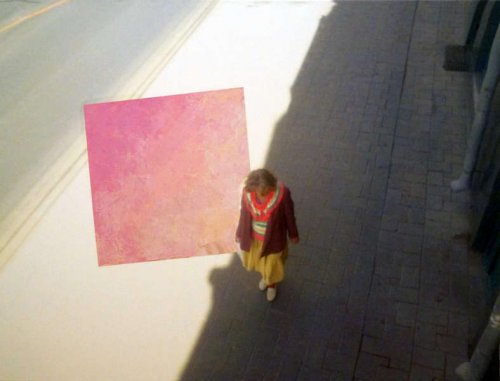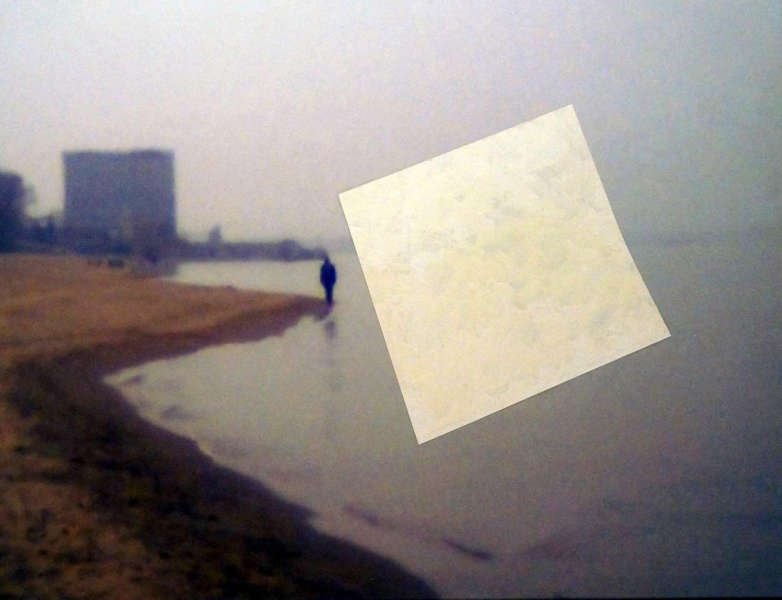
Accueil > Les rubriques > Cerveau > Look from Zero Point
Look from Zero Point
« An Artwork is the Apparatus for Watching Emptiness »
, et
Nelya and Roman Korzhovs’ exhibition “Next – nothing”. Samara Art-center, September, 25, 2014 – October, 5, 2014.
Konstantin Zatsepin, exhibition curator
Roman and Nelya Korzhovs’ field of vision shows not so much the subjects themselves as the space between them. Not things, but air they are immersed in. Unsteady but active matter “between” a human being and a landscape, a human being and a thing, or two human beings. This matter consists of time – it is the structures of time that authors are trying to catch, making an external distant timeless type of meditativeness. Internal spectator of their artworks always sees them from “zero point” where time is switched to the pause position. This gap between an accomplished act and a future perspective allows to feel the matter of time, to see its “texture”.

Roman Korzhov is the author of enigmatic visual readymades. His deep and desolate black-and-white video landscapes are pure continuance, silence of space. In the “Event Horizon” series the artist removes himself, dissolves in the frame which loops the landscape. The name of the series is a term of general relativity theory, specifying the area around a black hole with so great gravitation force that no signal can pass through the borders and reach an external observer. Landscape in Korzhov’s works appears as a cover having depth but at the same time an obscure void lining which the observer’s sight cannot reveal but can only slide along the “body”.
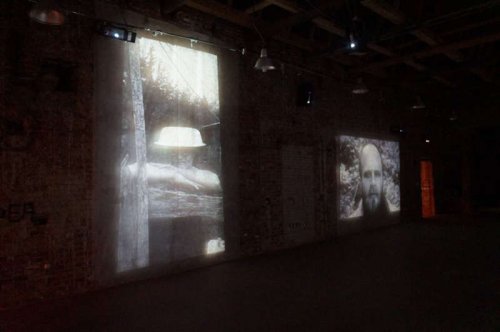
The same method Korzhov uses for his works with real people in his new series – the “Missing”. If a portrait in its classical meaning presents face-character as a timeless integrity taken from the flow of time, then a video portrait proposes a spectator to experience another person’s image as a continuance and to immerse together with this another person into the Present. The main observed object in those artworks is the gaze of another person. This gaze implies some latent contents. Characters of the “Missing” are looking through, into emptiness, without seeing a spectator in front of them. Those people, according to the author, are “absent in themselves”, projecting their experience of absence to the onlooker. We see the gaze itself but not the personality. Thus the portrait genre is being subjected to the defamiliarization and destroyed, and only its cover is left.
The visual material used by Roman Korzhov is isolated from the flow of the present, living its own autonomous life. Nelya Korzhova more often works with everyday life as it is. This work is being done on the micro level, applying the method of intensive looking at the nuances, appearing first of all in dynamics and movement. Abstract pictures by Nelya Korzhova similar to “white noise” of empty TV screen deal with the smallest elements caught in the field of the picture.

Her photo session “Next – nothing” shows deserted industrial landscapes, gaping ruined wastes, belonging to the past. The future which must come and replace them has not yet arrived and its arrival is postponed. In this series the artist combines visual images with verbal messages though in an ultimately ascetic form of negative pronouns and adverbs. This series is a sort of visualized poetry.
The new seria by Nelya Korzhova « Inland » is one of the key points of the exposure. It’s a minimalistic synthesis of photography and painting in one plane. The objective row is taken from everyday background, but reduced to primary bases : water and earth, light and shadow, up and down, line of horizon. There’s a man in the series, but just as a faceless silhouette, as a generalised « sign of a man », without whom the landscape would finelly turn into abstraction. Precisely the man figures, going to the spectator from the deep of space, indicates the depth of the plane. Conditional people exists in this continuum with the geometric bodies, whose complex is made by the picturesque layer atop the photographic layer. Thus objective and non-objective worlds combines into totality as if in « Next — nothing » series the photograhy and poetic text did. The suprematic matters finds the materiality. The plane and the depth begin co-exist. The dinamic to the series is imparted by the centarl motif of moving — the figures are moving, or drifting nomadically, without the aim. The idea of nomadic drifts is congenial to Nelya Korzhova and her curatorial practice : creating situations when a great number of spectators move from one artwork to another.
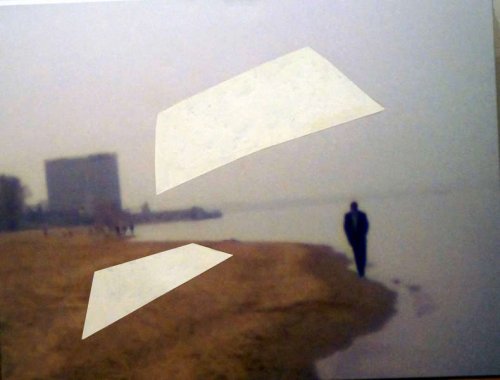
As a whole the exhibition can evoke mixed emotions – from the calm before the storm to intense anxiety. Still, they are not specific emotions but only “phantom feelings” which the authors of the exhibition are trying to capture and share with spectators.
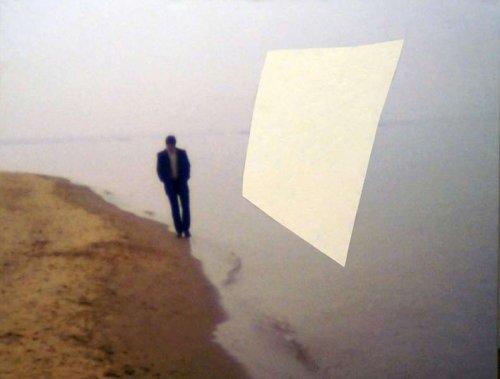
Nelya Korzhova and Roman Korzhov interviewed by Konstantin Zatsepin

About “Next – nothing” exhibition
Konstantin Zatsepin : Is it a kind of “straight message” for audience in your exhibition ? Something like “everything’s wrong here – it’s time to shove off” ? Or vice-versa - “it’s OK, let’s go on contemplating” ? Is the exhibition soothing or conflict one ?
Nelya Korzhova : “Next – nothing” word-combination itself contains a conflict of concepts. “Next” is heading for future, for expectations of something good, but at the same time it implies a painful postponement of something important and essential. And “nothing” is like a “further silence”. Hazy dawn. The carnival is over – no more dancing and singing, no more mummers and firecrackers – erything’s gone as the night dissolved. Awakening is close. I’m ready for it now – it’s even desirable for me. Understanding of zero is congenial to me these days. Calm acceptance of a situation when you are promised nothing.
KZ : As for me, I find it very difficult to stay “calm” as you have nothing to expect. Is it a calmness of being doomed ?
NK : It’s rather being in some new reference point. This is a special fascination of zero – the purification which follows after a tectonic shift, after “an explosion”, making you independent and all-sufficient.
KZ : In our “Laboratory” we call it the state of “zeroing”.
Roman Korzhov : Personally, I think of this exhibition as a statement about balance, some certain center of gravity with no deviations possible. To label it I use a theory-of-relativity term “event horizon”. This is a metaphor for “fulcrum”, for some fixity expressed by figurative means. The farther you go away from that center the more hollow you get, the nearer you come – the more “filled” you get. The genuine sensation of freedom or “inner” balance is extremely passing. Art is the only way to “capture” it, to expose it “fixed”.
KZ : In addition to pause-related subject the exhibition covers a variety of motives concerned motion — what kind of motion is it ?
NK : Generally I’m very interested in the subject of inconstancy and movement as such. Thus I’m always trying to develop Shiryaevo “nomadic show” as a process of continuous moving. This creating of art-whirlpool gives me real pleasure. In the same way my non-objective art is like building of some kind of mystery play. I’m trying to avoid any sort of strict limitation (like square or circle) within an artwork – a possibility of transformation as a basis of picture is important for me. And I consider horizon mostly in two dimensions, as an intersection. From one point of view it is a straight line. For example, I have series titled “Film” with black curtains on both edges of pictures. From the other point of view horizon is a vector directed deep down to the inner space of canvas. It could be illustrated with the series of structural works. And this conflict of views is important in its core. Sometimes this vector could be seen as a dot only – it turns out some point from inception of the idea to its correlation to the audience and backwards. You never know what would be the final result. This situation is “trigeminal nerve” in some way. This looped reaction is an important point for me.
KZ : What attracts you in photography and video art ?
NK : I’ve got a feeling the perception of photography as such has completely changed – these days we percieve things through working film projector, large screen with luminous photographs on it.
RK : It’s like being to the movies face to face with the screen.
NK : And the scale difference really matters in this case. It is important that screen is bigger than a spectator. It’s probably a kind of protective response to pictures on mobile’s screens.
RK : Using black-and-white images is another crucial point for me. For one thing, it helps you to avoid inevitable colour symbolism which is always adding some uncontrollable associations. Secondly, it corresponds to elementary striving for simplicity of statement. So all you’ve got is the concept of light and shadow (as the absense of light which is outside of “event horizon” and could’t be seen by “observer”). I’ve always aspired for such simple models.
KZ : Could you state some kind of formula of your today’s activity ?
NK : We have our children. Well, I’m reading now Yuri Albert’s latest book “The Beginning”. He describes Chuikov’s artwork “Apparatus for Watching Emptiness and Infinity”. This title is very accurate and capacious, it makes a certain connection between conceptual element and minimalism. So an artwork itself is an “apparatus for watching emptiness”, although today’s artwork is not an object but communication.

About conceptualism and language of resistance
KZ : Well, as we mentioned Moscow conceptual art, tell me do you bring yourself into some correlation with this current of Russian art ? And what does it mean to be a conceptual artist these days ?
NK : I consider self-rejection as today’s crucial problem.
RK : Yes, it is an uncertainty begotten by certain circumstances. It generates fear, uneasiness and so on. The problem of trust and distrust appears. This sort of things is quite topical these days – actual meaning of trust, reputation.
NK : Is trust a thing of current importance for you ? As for me, I trust everybody. I trust completely and totally, because I’ve got nothing to hide. You have this problem of trust only when you’ve got something to hide. And this is the difference between Moscow conceptual artists and foreign ones – the westerners didn’t hide anything. They had been seeking out some discoveries for everyone, something like “hey, guys, the Earth spins !” And our folk hided the fact that they already got the thing.
RK : To my mind, it was a kind of small circle for “initiates” only. Some sort of today’s Google Circles.
KZ : Still, some of their issues interested people throughout the world.
NK : The very personalities of the artists were mostly interesting. When I look at photos of those folk I see them as the bundles of energy, men of the new knowledge.
KZ : I could admit the point that the term “conceptual art” served mostly as a metaphorical cover for Moscow artists. I mean today none of them could be identified as a conceptual artist. Kabakov is not a conceptual artist at all. His art is pure lyrics, endless Dostoevsky-like reflection, “little man” subject – nothing but Russian classics. It has absolutely nothing to do with whatever Kosuth, who simply stated “this is a chair and here’s a picture of the chair”. Nevertheless, the legacy of Moscow “conceptual artists” is a significant fact of culture.
RK : I think that Moscow conceptual art as a local phenomenon is quite self-proportional. It is Moscow “incarnation” of western outlook and example of transformation of art perception. I don’t mean a calibre of the artworks – I’m just talking about a “local” calibre of ideas.
KZ : How so ? Kosuth exactly represented this kind of local movement, while Russian conceptual art assumed a function of speaking for the whole art against the background of Soviet non-art.
NK : They were just forced to act this way. All those hardships and never-ending inner opposition. Their rejection of the System could ruined their lives now and then. That’s why this permanent “clowning around” became some sort of language for our conceptual art. And when you constantly express yourself through “clowning around” you finally have it as a secondary stand.
KZ : All right, but still the language of “clowning around” is eleborate one. And it is certainly the language of resistance.
NK : Exactly so. Eleborate language is an important aspect. For example, “Fluxus” represented resistance as well. But on the other hand they were rebels.
KZ : The language of Russian contemporary art was the language of resistance from the very beginning. A form of free utterance about freedom. In our country making art is incompatible with being replete.
NK : This is purely Marxist point of view... Just look at Yuri Albert these days – he’s the most kindly treated artist and still he’s writing all along about how hard it was to break through in the beginning.
KZ : Well, it won’t be long... He’s such an ardent oppositionist at present, although never has been the one in the past.
NK : Why, by the way ?
KZ : He is a bred-in-the-bone trend catcher. But the thing is everything changes every half-year these days.
NK : …or it’s just because of the fact that our conceptual art was impregnated with the idea of being integrated into global art space or just escaping to the West. And all of a sudden emigration became possible. But our artists indeed felt stifled in the Soviet Union, and they really looked for another art. They hoped to be needed “there” badly. So that’s where “a new tradition” of self-rejection came from.
KZ : All right, let’s refer to Eastern Europe – for example, quite potent conceptual art of Poland. Did they strive for the same thing ?
RK : The artists themselves define the matter – whether they could overcome their local context or not.
KZ : As judged by the fact that Polish conceptual art is better-known than Russian one, it turned out they managed to overcome and we didn’t ?
NK : In fact, the “nerve” of post-Soviet fracture passed through Poland, and to my mind it provoked that burst of artistic activity. The same thing for Estonia, Lithuania, Latvia... But we cannot help seeing that the countries of the former Soviet Union are of special interest for Europe and the United States. And to integrate into own system only those who are more prepared is a regular policy. We quite understand that it’s not only game of art, but market fights as well. Poland always identified itself as a part of the Europian Union. There were plenty of reasons including religious ones. And contemporary art in Poland helps to improve living standarts of the whole population. And Russia... - it is so vast. A smaller one could be supported... and a bigger one should take care of itself. The trouble is that quantitatively the art scene in Russia is equal to the ones abroad. But as a percentage of the whole population it’s just crumbs. And even those find themselves mostly in Moscow.
KZ : Russia is more cynical. And the art-scene is quite respective here.
NK : Yes, and in my opinion this young art-gang of Moscow is much more cynical than Europian one. The openness of Europeans is based on their easy life. People there devote themselves to art because they really want to. Moscow art-circle is highly-motivated to live solely in Moscow because of money issues. They understand that as soon as they move out of Moscow they lose everything. Why do they work ? - they only make their living. They will be paid not a dime in their hometowns. The Europian artists don’t sell themselves so badly. First, the demand is less. Second, they always have grants, reliefs or money from parents. Or an opportunity to make some paid social work. So it’s not such a straight commercial connection as we have. But in our case this connection imports a certain flavour into the artistic circle, a flavour which is quite dubious. And here comes that permanent thing of “clowning around”, starting, as we said before, with conceptual artists.
KZ : But in the USSR conceptual artists didn’t depend on the sales. They all had official employment. For them art was the way of doing what they wanted to do.
NK : Yes, at that time you could be just a janitor, it didn’t really matter.
RK : Now Maurizio Cattelan – do you think he is a political conceptual artist of current importance ?
NK : I think so.
KZ : Yes, but he makes so much buffoonery and never shows his views in a straight way. He is too much a joker to be actually interpreted as a protester.
NK : That’s because of his success.
KZ : Well, that’s the very reason for his success.
NK : And Marina Abramović, for example, is a real star, but in recent years the attitude to her is not easy, because she suddenly became mostly fashion-oriented. Yet Valie Export, of the same age, never did – on the contrary she primarily devotes herself to the aspect of visuality. This is probably an understanding of how political artists became just a part of political design.

About relevance and issue of “why we visit exhibitions ?”
RK : The very question of “relevance/non-relevance” seems obsolete and extremely boring to me. The question destroys itself, because we have this feeling of affectation of the whole situation, which in its turn begets the feeling of information being changed superquick. But what’s the “newness” of today, if tomorrow we’ll be presented with something very-very “new”. Nowadays all the routine is carried out by computer, managing millions of hard-disc data sectors and thousands of Internet addresses with unbelievable monotonous constancy. And all we have is an obsession of searching for something “new”. And if that bloody boot sector does freeze up, then it grows real crappy and, thus, “relevant”.
KZ : In spite of this high information saturation, there is only a little of genuine new.
There are some meaning patterns, which steadily reproduce themselves, making an illusion of being something new.
NK : The same thing with that “what for ?” question. If you’re in love you don’t want to mess with this speculation business at all.
KZ : As a matter of fact, you never can answer “what for ?” question. It doesn’t imply answering, but creates a certain situation.
RK : In my opinion, a perception of any artwork is concerned with some kind of onlooker’s affect – whether a spectator feels that special artist’s fun of making the artwork or not. Of course, I’m talking not only about our niche, but the matter in general.
NK : I really dig Rothko, and Degot says he’s just painted a half red and a half green.
KZ : Well, she doesn’t “dig”, does she ? As an art critic she should realize what’s the “dig” thing here.
NK : …but she thinks that “abstract art was conceived as a grandiose swindle, as a rude refusal to give a philistine his vulgar nude pictures”.
KZ : But Rothko really did this simple painting. Why shouldn’t somebody dig it ? The thing is that Rothko doesn’t fit a certain intellectual frame shaped by Degot.
RK : The case of Rothko is very significant. One would think there is absolutely nothing to look at : red top – white bottom or black top – purple bottom or no top and no bottom at all, some sky-blue pink crud – any wall-and-brush painter would do it better, more smoothly. Yet, it is a special THING – you never can tell where it comes from or where it goes away – you just get goosebumps as you look at that. By the way, in Polish “art” spells like “sztuka” which, in its turn, in Russian means “a thing”. That’s why making a demarcation between emotional and intellectual kinds of perception is so difficult and needless.
KZ : I don’t think it’s needless. Аnyway art begins with emotions. The simplest example is cinema. That’s the common way of writing a Hollywood script : here would be “the laughing point” and there would be “the weeping point”. As for intellectual perception it is quite a separate matter.
NK : The art of thinking in general depends on the context. This is the matter of difference between provinces and non-provinces. Even in Germany it is still visible. You come in some town and see smart, intellectual people all around. You go couple of stations away and notice the locals don’t bother themselves with too much thinking. You feel it from the very beginning, even before first “hello-goodbye”. You feel it literally physically. Provinces don’t have this high field of intellectual life. They don’t feel and don’t think in provinces – they don’t know WHAT to feel or think there.

NEXT – NOTHING, Nelya Korzhova and Roman Korzhov
Photography, painting, video art
Roman and Nelya Korzhovs’ field of vision shows not so much the subjects themselves as the space between them. Not things, but air they are immersed in. Unsteady but active matter “between” a human being and a landscape, a human being and a thing, or two human beings. This matter consists of time – it is the structures of time that authors are trying to catch, making an external distant timeless type of meditativeness. Internal spectator of their artworks always sees them from “zero point” where time is switched to the pause position. This gap between an accomplished act and a future perspective allows to feel the matter of time, to see its “texture”. The exhibition can evoke mixed emotions – from the calm before the storm to a stressful tension. They are not specific emotions but only “phantom feelings” which the authors of the exhibition are trying to capture and share with spectators.
Konstantin Zatsepin, exhibition curator
Personally I think of this exhibition as a statement about balance, some certain center of gravity with no deviations possible. To label it I use a theory-of-relativity term “event horizon”. This is a metaphor for “fulcrum”, for some fixity expressed by figurative means.
Roman Korzhov, artist
“Next – nothing” word-combination itself contains a conflict of concepts. “Next” is heading for future, for expectations of something good. And “nothing” is like a “further silence”, another beginning. This feeling of being in some new reference point is congenial to me these days. This is a special fascination of zero – the purification which always follows after a tectonic shift, after “an explosion”.
Nelya Korzhova, artist
